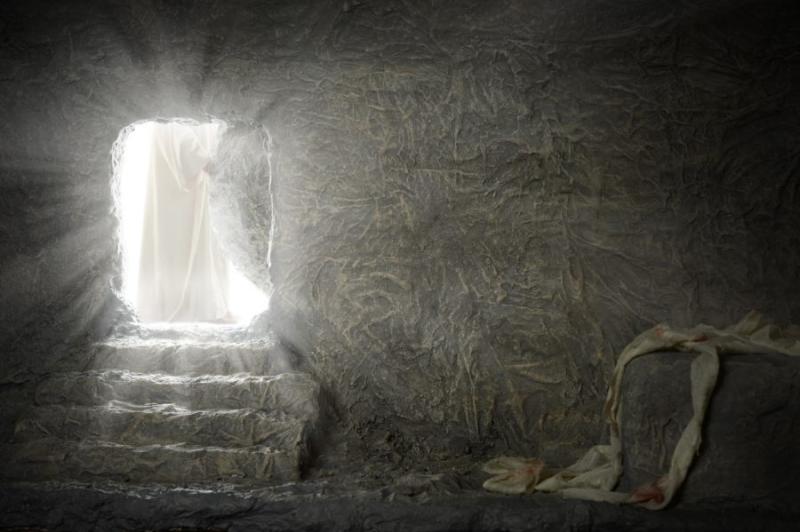We Know Jesus Rose Because We Know How He Was Buried



The conclusion can’t be avoided: the historic person Jesus of Nazareth was dead, buried, and made alive. Only an event of supernatural origin could account for his resurrection. One reason we know this? How he was buried.
Jesus’s Body
When Joseph of Arimathea and Nicodemus prepared Jesus’s lifeless body for burial, they used “a mixture of myrrh and aloes” (John 19:39). This was not just a modest amount of ointment. The Greek term used for the weight of this mixture can mean up to 100 pounds.
The Greek historian Herodotus tells us that myrrh was used to embalm, while aloe provided a lovely scent. John’s account tells us that these ointments were entwined with the long winding-sheet wrapped tightly around Jesus’s body (19:40).
Great care was taken in the preparation of the body. Acts 9:37 mentions the Jewish custom of bathing a corpse prior to burial. There is little doubt before Jesus was wrapped in his burial shroud, his horribly marred and bloody body was cleansed by the faithful Pharisees who bravely had asked for it. And, as part of the Jewish tradition, they closed his eyes.
The prophet Isaiah tells us that the appearance of the Messiah would be, after his torture and murder, “so marred” it would be “beyond human semblance, and his form beyond that of the children of mankind” (52:14). The pain, even trauma, of cleansing this mangled, gruesome body must have been great for Nicodemus, Joseph, and all who assisted them.
The burial cloth was bound tightly around the corpse. Up to 100 pounds of ointment saturated it. The body would have been made completely immobile. What’s more, Jesus’s head was wrapped in a separate cloth (as was that of Lazarus, John 11:44).
These is no possibility that, as some skeptics charge, a somehow reawakened Jesus could have wriggled-out of his shroud or not been suffocated by the head-wrapping, itself soaked in choking ointment.
Jesus’s Tomb
Nicodemus place Jesus’s corpse “in his own new tomb, which he had cut in the rock. And he rolled a great stone to the entrance of the tomb and went away” (Matthew 27:60).
Nicodemus must have had assistance, because the stone was enormous. There were two type of stone used. One was the circular stone, carved much like a grinding-stone, stood on its edge. The other was a large block of stone, carved something like a cork and plugged into the rather small opening of the tomb.
The small size of the tomb’s entry is confirmed by John’s account, which tells us that Peter had to bend to look into it (20:5).
The cork-type plug was more common, but it really doesn’t matter which kind was used. Once dislodged, it could have been rolled away from the entry, just as the circular stone.
The Seal and Guards
When a group of priests and Pharisees came to ask Pilate for a guard over Jesus’s grave, he gave it. One can almost hear the contempt in his voice when he said to them, “You have a guard of soldiers. Go, make the tomb as secure as you can” (Matthew 27:65). In other words, “What more do you want?! I had him killed at your request, and now you want a guard, to boot!”
But once more, the devious Pilate yielded. And he knew the gravity of what he was doing. A Roman seal was not just cautionary. It had the authority of the Roman empire. To break it was to defy Rome — a criminal offense, one that could be punishable by death. As to the seal itself, one scholar has written that it was made of “a soft, moldable substance, probably clay, that was imprinted with the Roman imperial seal and attached to the stone with a rope,”
The Roman guard was probably made up of teams of two men at a time, spelling each other every few hours from the evening of the burial until the resurrection. They were heavily armed, a double-edged, finely sharpened swords and spears with points like long razors. Only a heavily-armed group would dare fight them. And to fight Rome meant to be hunted-down and executed.
To sleep while on guard meant devastating punishment. The Roman historian Polybius writes that once a court-martial had passed judgment on the soldier found sleeping, the entire company of soldiers would beat or stone him. If he somehow managed to survive, he would be an outcast from his family.
The Tomb Is Empty
The tomb is empty, but its silent vacancy speaks more loudly than anything in history. Jesus is alive. And he comes to live in all who call on Him for forgiveness and new life.
Don’t delay. Make Resurrection Day your spiritual birthday. Ask him to roll the stone from your heart. He is eager to enter in.


